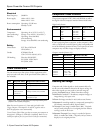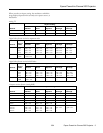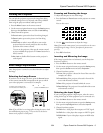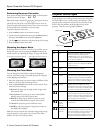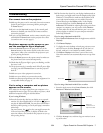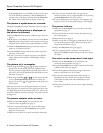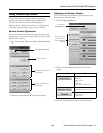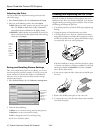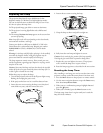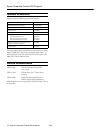
Epson PowerLite Cinema 200 Projector
8 - Epson PowerLite Cinema 200 Projector 1/04
If the
Arrange option isn’t available, you may need to select
one of the Simulscan resolutions. Click the
Monitor icon
and then select a Simulscan resolution from the
Resolution
box. (Allow a few seconds for the projector to sync up.)
The picture is upside-down or reversed.
Change the Projection setting in the menu system (see page 5).
Only part of the picture is displayed, or
the picture is distorted.
❏ Press the Aspect button to select a different aspect ratio (see
page 2).
❏ If the Aspect is set to
Zoom, you may need to use the Zoom
Caption
option in the projector’s menu system to see the top
or bottom section of the screen (so that subtitles are visible).
❏ Check the
Output Scaling setting in the menu system to
make sure it’s adjusted correctly.
❏ Use the
Position setting in the menu system to reposition
the image on the screen.
❏ If you’ve connected a computer and you see only half the
image, make sure the computer’s Dual Display setting is
turned off.
The picture isn’t rectangular.
❏ If the image looks like or , the projector has been
placed off to one side of the screen and angled toward it.
Face the projector straight ahead (instead of at the center of
the screen), then use the horizontal lens shift knob to center
the image (see page 4).
❏ If the image looks like or , use the remote control
to access the
Keystone function to correct its shape (see
page 6). Or press the and buttons on the projector’s
control panel.
Note: You won’t have to use the Keystone function to correct the
image if you place the projector level (not angled up or down) and
at a height between the top and bottom of the screen. Then use the
vertical lens shift knob to position the image. This produces the best-
looking picture.
The picture contains static or noise.
❏ Make sure the Input Signal is set correctly for your
connected video equipment (see page 5).
❏ If you’re viewing still images and you notice flickering or
horizontal lines, turn on the
Progressive setting in the
projector’s menu system.
❏ Make sure your cables are securely connected at both ends.
❏ If you’re using an extension cable, you may pick up
interference unless you use a signal amplifier. Or try turning
on
Noise Reduction in the menu system.
❏ If you’re displaying the same image on your computer and
projector screen, try turning off your laptop’s LCD display.
The picture is blurry.
❏ Make sure the Input Signal is set correctly for your video
equipment (see page 5).
❏ There may be dirt on the lens. Gently clean the lens using
lens-cleaning tissue.
❏ Adjust the focus (see page 5).
❏ Make sure the lens is not fogged by condensation. If you’ve
just moved the projector from a cold environment, wait a
couple of minutes before using it.
❏ Adjust the
Sharpness setting (see page 5).
❏ If you’re projecting from a computer, you may need to
adjust the
Tracking and Sync settings (see the User’s Guide
for details).
The colors on the screen don’t look right.
❏ Make sure the Input Signal is set correctly for your
connected video equipment (see page 5).
❏ Press the
Color Mode button on the remote control to select
a different color mode (see page 6).
❏ Check the brightness and contrast settings in the menu
system, as described in the User’s Guide.
❏ Fine-tune the colors with the menu’s color settings, as
described in the User’s Guide. You can also use Cinema
Color Editor to adjust each color individually (see your
User’s Guide).
❏ If the picture looks dark, you may need to replace the lamp
(see page 11).




